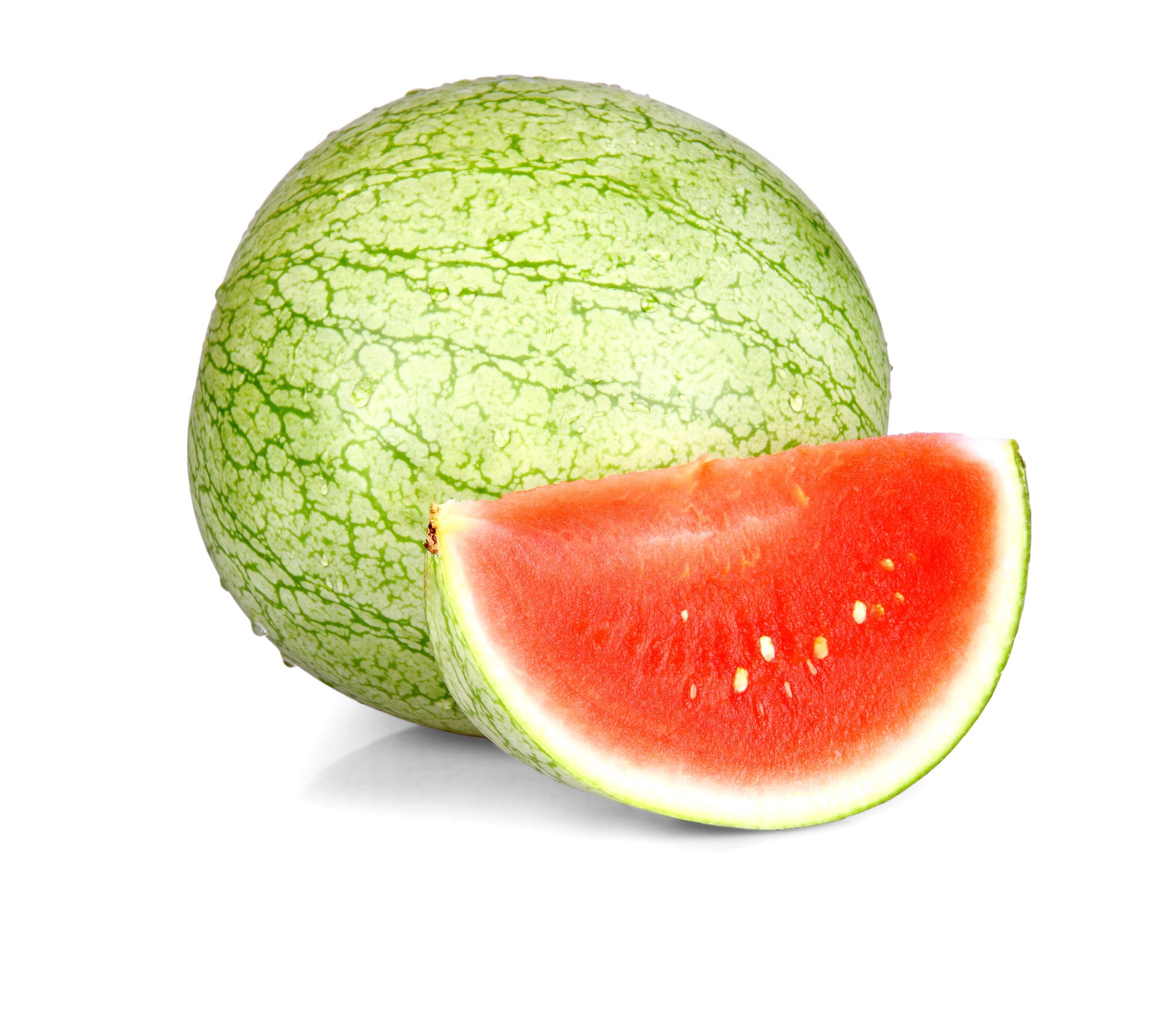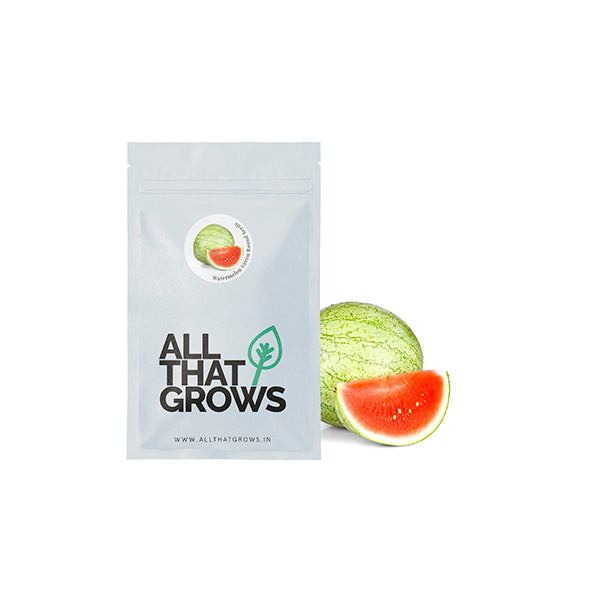



Watermelon Green Round Seeds
Seed Type : Non-Hybrid, Open Pollinated and Non-GMO
Sowing time: November to February-March
Fruit picking: After 80-85 days from sowing
Fruit shape: Round
Fruit colour: Light grey green
Average weight: 3-4 kgs
Flesh: Deep red
Sweetness: Very sweet
- SOWING
TIMENov - Feb/ March
- Sowing
DistancePLANT TO PLANT 6 FT LINE TO LINE 2 FT
- Fruit
Weight3-4 Kgs
- Fruit
ShapeRound
- Days to
maturity80 - 85 days
- Details
- How to sow
- Reviews
Watermelons are a member of the botanical family Cucurbitaceae. This cousin to cucumbers, pumpkins and squash, watermelons are considered a vine-like flowering plant that is actually native to Southern Africa, and it is there that the wild varieties are in the greatest abundance. These varieties range from super sweet to bitter, and vary in size as well. They moved north to Egypt, and were cultivated in the Nile River Valley, and eventually moved east into China, roughly 1,000 years ago.
Despite popular belief that watermelon is made up of only water and sugar, it is actually a nutrient dense food. It's refreshing quality and sweet taste helps to combat the heat and also provides a guilt-free, low maintenance dessert for kids and adults alike to enjoy. Watermelon includes significant amounts of vitamin C, calcium, magnesium, fiber, protein, and a very large amount of potassium. Furthermore, they contain vitamin A, vitamin B6, niacin, thiamin, and a wide variety of carotenoids and phytonutrients, including lycopene. As an excellent source of the strong antioxidant vitamin C as well as other antioxidants, watermelon can help combat the formation of free radicals known to cause cancer.Watermelon and watermelon juice have been shown to reduce muscle soreness and improve recovery time following exercise in athletes.
Eat them raw, make a dessert (sorbet) or simply bite into a nice chunk of the Melons, whatever and however, you have them, you will love every pinch of them! So start growing them in your gardens now.
Planting instructions
Watermelon vines are really tender, wait at least two weeks after frosty winters/ spring before sowing. Start seeds indoors around a month before transplanting.
Amend soil with aged manure, seaweed, and/or compost before planting. Watermelons are heavy feeders.
Growing the vines in raising rows, known as hills, ensures good drainage and will retain the sun’s heat longer.
Place the plants about 2 feet apart in a 5-foot-wide hill. If you’re growing in rows, space them 6 feet by 6 feet apart. After you are done transplanting, cover the plants with row covers to keep pests at bay.
Growing Requirements
watering
While melon plants need 1 to 2 litres of water per week. Avoid overhead watering. Reduce watering once fruits start to grow.
pests
These pests are known to attack watermelon- Aphids, Cucumber Beetles, Squash Vine Borer Moths, Fusarium Wilt, Anthracnose, Cabbage looper, Cutworms. The above mentioned pests may cause the following symptoms - Small, yellow-brown spots; irregularly shaped or circular dark brown lesions on leaves; fruits are small and pale in color,Large or small holes in leaves.
soil
Watermelons prefer a soil pH between 6 and 6.8. Watermelons grow well in loamy, well-drained soil.
spot
Watermelon plants need a minimum of 6 hours of sun every day.
temperature
Melons need warm temperatures. The optimum soil temperature for root growth is in the range of 20 to 35°C [68 to 95°F].
how to harvest
Look at the colour at the bottom. A green watermelon will have a white bottom; a ripe melon will have a creamy or yellow coloured bottom.
Check the tendril. If it’s green, wait. If it’s half-dead, the watermelon is nearly ripe or ripe. If the tendril is fully drained, it’s ripe or overripe.
Stems should be thin with a sharp knife close to the yield.
Watermelons can be stored uncut for nearly 10 days. If cut, they can last in the refrigerator for approximately 4 days. Wrap tightly in plastic, refrigerate.

Customer Reviews
The productiveness of any seed we sell is subject to your local climatic conditions*, the sowing method you adopt, and your commitment to the planting process. We give no warranty, expressed or implied, and are in no way responsible for the produce.
Please note that all our seasonal recommendations/ sowing information is as per the local climatic conditions. *For more information on the optimum conditions required for growing seeds in your region, please contact us at, hello@allthatgrows.in or Whatsapp us at, +91 8544865077
Questions & Answers
Have a Question?
Be the first to ask a question about this.




Watermelon Green Round Seeds
Seed Type : Non-Hybrid, Open Pollinated and Non-GMO
Sowing time: November to February-March
Fruit picking: After 80-85 days from sowing
Fruit shape: Round
Fruit colour: Light grey green
Average weight: 3-4 kgs
Flesh: Deep red
Sweetness: Very sweet
Watermelons are a member of the botanical family Cucurbitaceae. This cousin to cucumbers, pumpkins and squash, watermelons are considered a vine-like flowering plant that is actually native to Southern Africa, and it is there that the wild varieties are in the greatest abundance. These varieties range from super sweet to bitter, and vary in size as well. They moved north to Egypt, and were cultivated in the Nile River Valley, and eventually moved east into China, roughly 1,000 years ago.
Despite popular belief that watermelon is made up of only water and sugar, it is actually a nutrient dense food. It's refreshing quality and sweet taste helps to combat the heat and also provides a guilt-free, low maintenance dessert for kids and adults alike to enjoy. Watermelon includes significant amounts of vitamin C, calcium, magnesium, fiber, protein, and a very large amount of potassium. Furthermore, they contain vitamin A, vitamin B6, niacin, thiamin, and a wide variety of carotenoids and phytonutrients, including lycopene. As an excellent source of the strong antioxidant vitamin C as well as other antioxidants, watermelon can help combat the formation of free radicals known to cause cancer.Watermelon and watermelon juice have been shown to reduce muscle soreness and improve recovery time following exercise in athletes.
Eat them raw, make a dessert (sorbet) or simply bite into a nice chunk of the Melons, whatever and however, you have them, you will love every pinch of them! So start growing them in your gardens now.
Seed Type : Non-Hybrid, Open Pollinated and Non-GMO
Sowing time: November to February-March
Fruit picking: After 80-85 days from sowing
Fruit shape: Round
Fruit colour: Light grey green
Average weight: 3-4 kgs
Flesh: Deep red
Sweetness: Very sweet
- SOWING
TIMENov - Feb/ March
- Sowing
DistancePLANT TO PLANT 6 FT LINE TO LINE 2 FT
- Fruit
Weight3-4 Kgs
- Fruit
ShapeRound
- Days to
maturity80 - 85 days
Planting instructions
Watermelon vines are really tender, wait at least two weeks after frosty winters/ spring before sowing. Start seeds indoors around a month before transplanting.
Amend soil with aged manure, seaweed, and/or compost before planting. Watermelons are heavy feeders.
Growing the vines in raising rows, known as hills, ensures good drainage and will retain the sun’s heat longer.
Place the plants about 2 feet apart in a 5-foot-wide hill. If you’re growing in rows, space them 6 feet by 6 feet apart. After you are done transplanting, cover the plants with row covers to keep pests at bay.
Growing Requirements
watering
While melon plants need 1 to 2 litres of water per week. Avoid overhead watering. Reduce watering once fruits start to grow.
pests
These pests are known to attack watermelon- Aphids, Cucumber Beetles, Squash Vine Borer Moths, Fusarium Wilt, Anthracnose, Cabbage looper, Cutworms. The above mentioned pests may cause the following symptoms - Small, yellow-brown spots; irregularly shaped or circular dark brown lesions on leaves; fruits are small and pale in color,Large or small holes in leaves.
soil
Watermelons prefer a soil pH between 6 and 6.8. Watermelons grow well in loamy, well-drained soil.
spot
Watermelon plants need a minimum of 6 hours of sun every day.
temperature
Melons need warm temperatures. The optimum soil temperature for root growth is in the range of 20 to 35°C [68 to 95°F].
how to harvest
Look at the colour at the bottom. A green watermelon will have a white bottom; a ripe melon will have a creamy or yellow coloured bottom.
Check the tendril. If it’s green, wait. If it’s half-dead, the watermelon is nearly ripe or ripe. If the tendril is fully drained, it’s ripe or overripe.
Stems should be thin with a sharp knife close to the yield.
Watermelons can be stored uncut for nearly 10 days. If cut, they can last in the refrigerator for approximately 4 days. Wrap tightly in plastic, refrigerate.



 Sign In
Sign In






